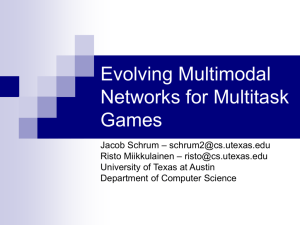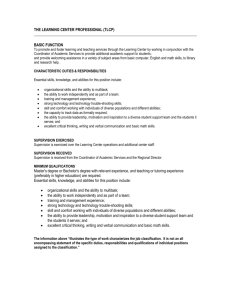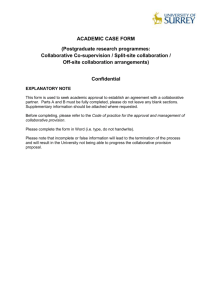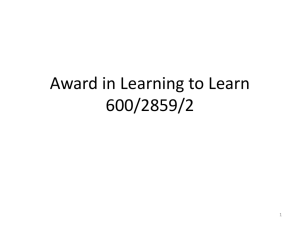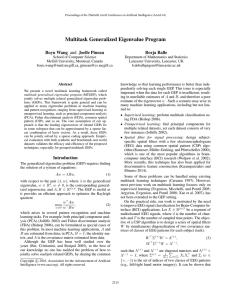Abstract
advertisement
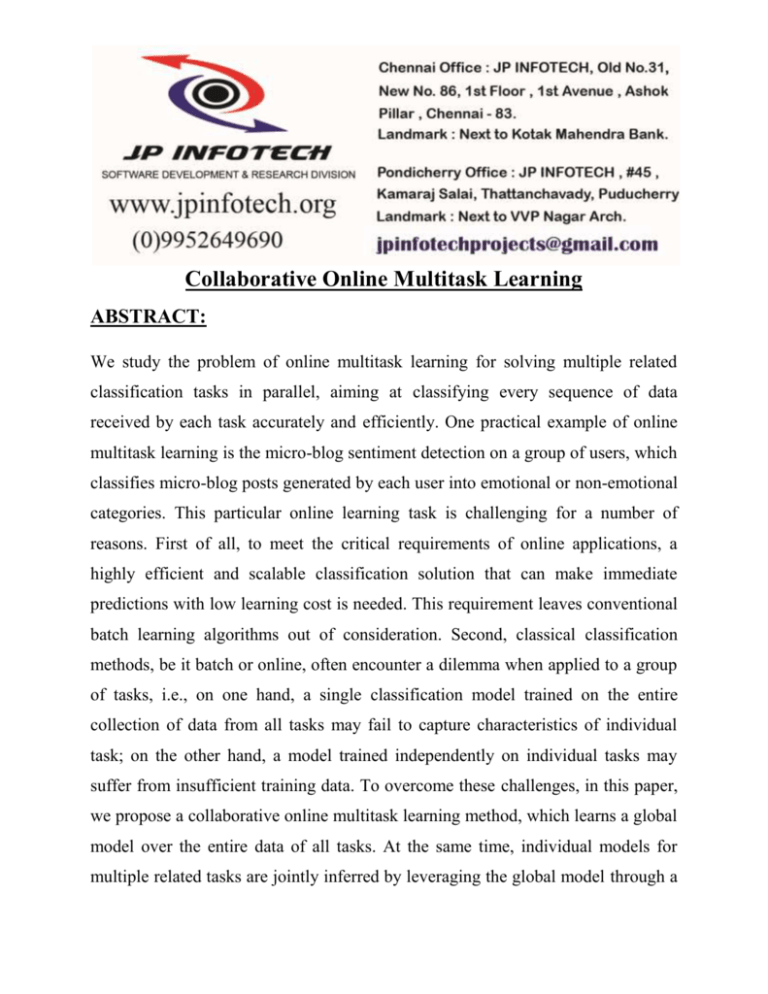
Collaborative Online Multitask Learning ABSTRACT: We study the problem of online multitask learning for solving multiple related classification tasks in parallel, aiming at classifying every sequence of data received by each task accurately and efficiently. One practical example of online multitask learning is the micro-blog sentiment detection on a group of users, which classifies micro-blog posts generated by each user into emotional or non-emotional categories. This particular online learning task is challenging for a number of reasons. First of all, to meet the critical requirements of online applications, a highly efficient and scalable classification solution that can make immediate predictions with low learning cost is needed. This requirement leaves conventional batch learning algorithms out of consideration. Second, classical classification methods, be it batch or online, often encounter a dilemma when applied to a group of tasks, i.e., on one hand, a single classification model trained on the entire collection of data from all tasks may fail to capture characteristics of individual task; on the other hand, a model trained independently on individual tasks may suffer from insufficient training data. To overcome these challenges, in this paper, we propose a collaborative online multitask learning method, which learns a global model over the entire data of all tasks. At the same time, individual models for multiple related tasks are jointly inferred by leveraging the global model through a collaborative online learning approach. We illustrate the efficacy of the proposed technique on a synthetic dataset. We also evaluate it on three real-life problems— spam email filtering, bioinformatics data classification, and micro-blog sentiment detection. Experimental results show that our method is effective and scalable at the online classification of multiple related tasks. EXISTING SYSTEM: Unlike batch learning methods, which assume all training samples to be available before the learning task begins; online learning algorithms incrementally build a model from a stream of samples, allowing for simple and fast model updates. They are thus naturally capable of dealing with large datasets and problems whose data arrive sequentially. The origin of online learning can date back to the well-known Perceptron algorithm, which updates the model weight by moving it a tad closer to each misclassified sample. Descendant Perceptron-like methods employ more sophisticated update strategies. DISADVANTAGES OF EXISTING SYSTEM: The classical multi-task learning approach focuses on learning the primary task without caring how the other tasks are learned. The classical multitask learning problem is often studied in a batch learning setting, which assumes that the training data of all tasks are available. On one hand, this assumption is not realistic for many real-world problems where data arrives sequentially. On the other hand, the batch multitask learning algorithms usually have fairly intensive training cost and poor scalability performance, as far as large real applications are concerned PROPOSED SYSTEM: In this paper, we investigate the problem of online multitask learning, which differs from the classical multitask learning in two aspects. First, our goal is to improve the learning performance of all tasks instead of focusing on a single primary task. Second, we frame the multitask learning problem in an online learning setting by assuming that the data for each task arrives sequentially, which is a more realistic scenario for real-world applications. Unlike batch learning techniques, online learning methods learn over a sequence of data by processing each sample upon arrival. At each round, the learner first receives one instance, makes a prediction, and receives the true label. The error information is then used to update the learning model. ADVANTAGES OF PROPOSED SYSTEM: The basic idea is to first build a generic global model from large amount of data gathered from all users, and then subsequently leverage the global model to build the personalized classification models for individual users through a collaborative learning process. We formulate this idea into an optimization problem under an online learning setting, and propose two different COML algorithms by exploring different kinds of online learning methodologies. (1) A single task online learning approach that simply learns a global model over the entire collection of data gathered from all the tasks, (2) a single task online learning approach that solves each task independently, and (3) a state-of-the-art online multitask learning approach. MODULES: 1. Two fold motivation 2. Formulation 3. Confidence Weighted Learning MODULES DESCSRIPTION: 1. Two fold motivation: First, as tasks often exhibit varying patterns, it is neither practical nor effective to learn a single global model for classification. Second, it is also not always possible to learn a good classification model for each task since training data available for a single task are often limited. For such case, it is reasonable to pool together data across many related tasks. Hence, a better solution is to combine these two approaches coherently. Specifically, the collaborative online multitask learning operates in a sequential manner. At each learning round, it collects the current global set of data; one from each of the engaged users/tasks, which are employed to update the global classification model. At the same time, a collaborative personalized model is maintained for each user/task. The individual collaborative classification model is subsequently updated using the latest individual data and the global model parameters. Therefore, our approach can leverage global knowledge for classification, while adapting to individual nuances via the collaborative learning way. 2. Formulation: Online multitask classification proceeds in rounds by observing a sequence of examples, each belonging to some user/task from set of K users/tasks. On each round, there are K separate online binary classification problems being solved jointly. We assume that data from all users/tasks can be represented in the same global feature space, so that it is possible to use the shared information between tasks to enhance each learning task. The first step of the collaborative online multitask learning builds a global classification model to exploit the commonality among tasks. We adopt the online passive aggressive (PA) framework to build a global model using data collected from all users at round t. The critical step of our collaborative online multitask learning is to apply the existing global model to collaboratively learn the each of the K individual user models. Using the same PA formulation, the goal is to learn a classification model for the kth user. The next step is to use the shared information learned by the global model to enhance each individual learning model. We formulate the collaborative learning model as a convex optimization problem that minimizes the deviation of the new weight vector from the prior collaborative one and the global one. 3. Confidence Weighted Learning: A current trend in online learning research is to use parameter confidence information to guide online learning process. Confidence weighted learning, proposed by Crammeret al., models the linear classifier hypotheses uncertainty with a multivariate Gaussian distribution over weight vectors, which is then used to control the direction and scale of parameter updates. Conceptually, to classify an instance x, a confidence weighted classifier draws a parameter vector w∼N(μ,∑) and predicts the label according to sign(w·x). In practice, however, the aver-age weight vector E(w)=μ is used to make the prediction. Confidence weighted learning algorithms have been shown to perform well on many tasks. In this section, we extend the proposed collaborative online multitask learning with the confidence weighted hypothesis. SYSTEM ARCHITECTURE: SYSTEM REQUIREMENTS: HARDWARE REQUIREMENTS: System : Pentium IV 2.4 GHz. Hard Disk : 40 GB. Floppy Drive : 1.44 Mb. Monitor : 15 VGA Colour. Mouse : Logitech. Ram : 512 Mb. SOFTWARE REQUIREMENTS: Operating system : Windows XP/7. Coding Language : ASP.net, C#.net Tool : Visual Studio 2010 Database : SQL SERVER 2008 REFERENCE: Guangxia Li, Steven C.H. Hoi, Kuiyu Chang, Wenting Liu, and Ramesh Jain “Collaborative Online Multitask Learning” -IEEE TRANSACTIONS ON KNOWLEDGE AND DATA ENGINEERING, VOL. 26, NO. 8, AUGUST 2014.
